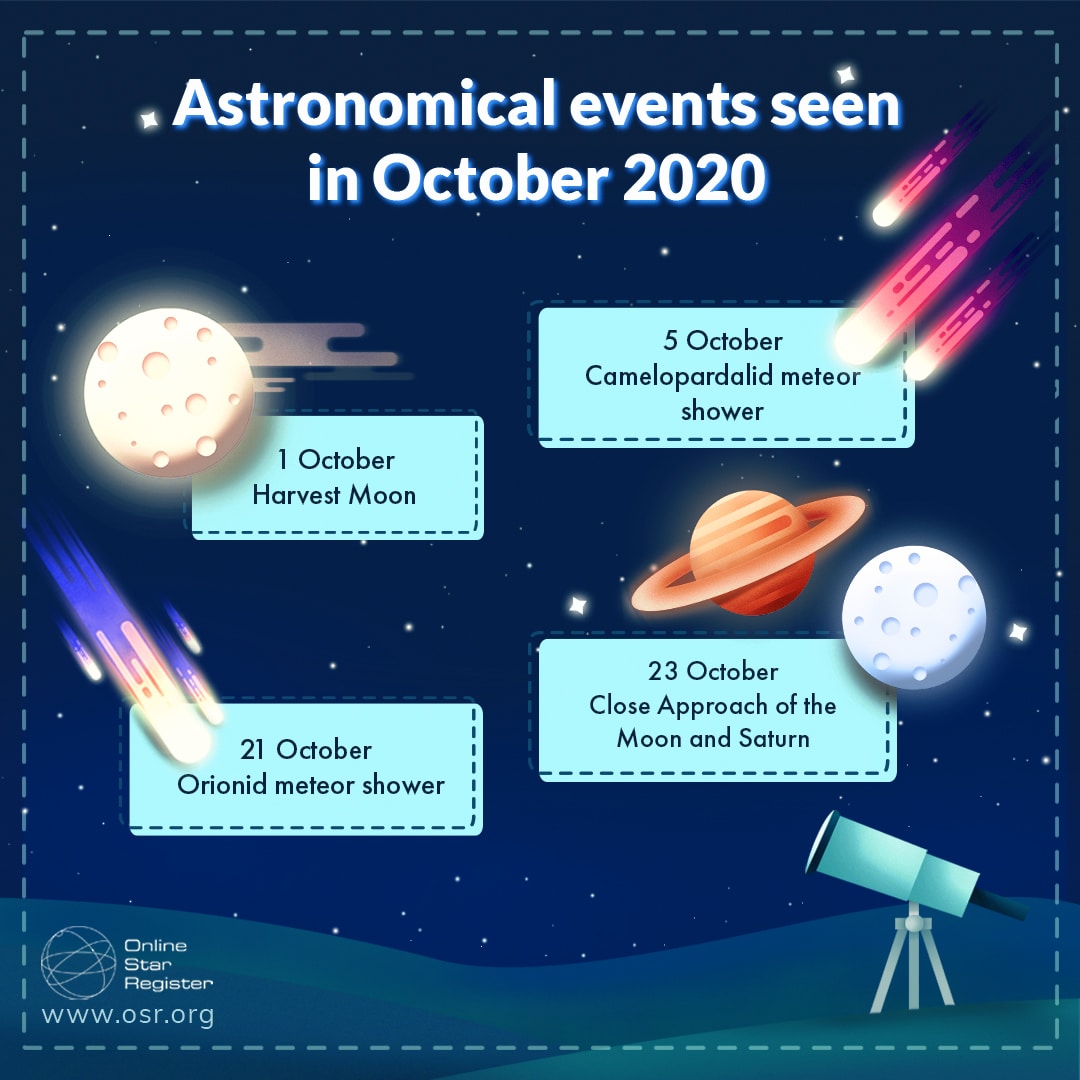The astronomical events of October 2020

October is full of surprises this year – especially surprises in the night sky! Come explore the astronomical events of October 2020 with us! Learn more about the Harvest Moon, the Camelopardalid meteor shower, the Orionid meteor shower, and the close approach of the Moon and Saturn.
Let us guide you through the astronomical events of October 2020. Once again, we have handpicked four mesmerizing astronomical events. Just like last month we have done our best to pick some amazing astronomical events that are visible with the naked eye! If you have binoculars or a telescope at your disposal, feel free to use them. Be sure to note down the dates of the events in your calendar so you won’t miss them!

Astronomical Event #1: The Harvest Moon
The full moon of the month October is called the Harvest Moon. The names of full moons are recorded from the early 18th century. It is said that the name of the Harvest Moon originates from a time before electricity, when farmers depended on the Moon’s light to harvest their crops late into the night. The Harvest Moon will be the first full moon to fall in autumn 2020.
After a full moon, the Moon continues its journey through the night sky and heads back towards the Sun. This causes the Moon to rise around 49 minutes later each day and within a few days it will only be visible in the pre-dawn and early-morning sky.
You can view the Harvest Moon on Thursday the 1st of October. At the exact moment when the Moon reaches full phase, it will be visible in the constellation Cetus. The constellation Cetus is also known as the Sea Monster. Because of the location of the constellation Cetus, the full moon will appear high in the sky at most latitudes.
Astronomical Event #2: Camelopardalid meteor shower
Meteor showers arise when the Earth passes through streams of debris left behind in the wake of comets and asteroids. However, in comparison to other meteor showers, the origin of the Camelopardalid meteor shower is still unknown. Camelopardalids meteor shower is said to have orbits, which indicates that the meteors occur because of a long period comet. However, the comet from which the Camelopardalis meteor shower resonates has not yet been discovered.
Hence the Camelopardalis meteor shower is still a bit of a mystery. Therefore, astronomers keep analyzing the Camelopardalids meteors. They hope that measuring more orbits may eventually help determine the orbit of the comet, enabling us to finally locate and track it.
The October Camelopardalid meteor shower will be active from October the 5th to October the 6th, producing its peak rate of meteors on Monday the 5th of October. The meteor shower can be seen nearby the constellations Camelopardalis and Draco. Both constellations are close to the star Polaris, also known as the North Star or the Pole Star. Because of the meteor shower’s location, it will only be visible from the Northern Hemisphere.
Astronomical Event #3: Orionid meteor shower
As its name suggests, the Orionid meteor shower’s radiant point is from the constellation Orion. The constellation Orion is also known as The Hunter and is visible from both the Northern and Southern Hemispheres.
In comparison to the Camelopardalid meteor shower, the origin of the Orionid meteor shower is known. The Orionid meteor shower happens when Earth is passing through the stream of debris left behind by Comet Halley. Halley is the only known comet that is regularly visible to the naked eye from Earth. Halley last appeared in 1986 and will next appear in mid-2061.
The Orionid meteor shower will be active from the 2nd of October to the 7th of November. The most meteors will be falling on Wednesday the 21st of October. You don’t need to know Orion or be looking at it to be able to view the meteors. After all, the meteors often don’t become visible until they are 30 degrees or so from their radiant point. Therefore, the Orionid meteor shower will appear in all parts of the sky.
Astronomical Event #4: Close approach of the Moon and Saturn
In October, the Moon and Saturn will make a close approach to each other, while at the same time being at conjunction. Any time two objects in the night sky pass each other, they’re said to be in conjunction. These sorts of conjunctions can happen multiple times every month.
The close approach of the Moon and Saturn on Friday the 23rd of October will be visible in the constellation Sagittarius. Sagittarius, also known as The Archer, is visible from both the Northern and the Southern Hemispheres. Need help finding the constellation? Use the OSR Star Finder App!
During this close approach the Moon will be at magnitude -11.8 and Saturn will be at magnitude 0.3. This means that they will both be easily visible with the naked eye. Unfortunately, the close approach will not be close enough to fit within the view of a telescope, but you will be able to see the Moon and Saturn with the naked eye or by using a pair of binoculars.
Enjoy exploring the night sky!
We hope to have given you enough reasons to go out exploring the night sky with the astronomical events of October 2020! From the Harvest Moon to the Camelopardalid and Orionid meteor showers and the close approach of the Moon and Saturn – there’s enough to discover!
Want to stay in the loop on the upcoming astronomical events?
